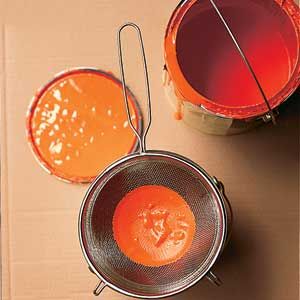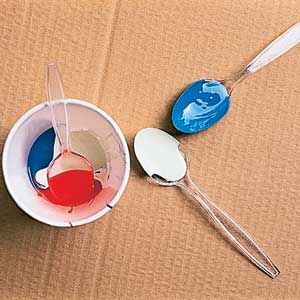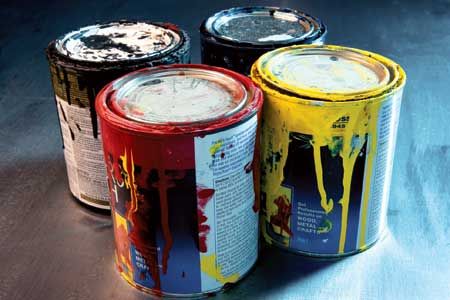Do you have leftover paint taking up space in your garage or basement? Don’t throw it away. Instead, consider mixing the paints to create custom colors and save some money. Dean Brawn, co-owner and vice president of Canada-based paint recycler Calibre Environmental Ltd., gave us a few tips for blending paint at home.
Paint Types and Compatibility
Before you start mixing paints, understand the different types of paint and which can be safely blended. Not all paints are compatible, and combining the wrong types can lead to disastrous results.
Different Types of Paint
There are several common types of paint you might encounter. These include the following:
- Latex (water-based) paint
- Oil-based paint
- Acrylic paint
- Chalk paint
- Milk paint
Each type has unique properties and uses. Latex paint is the most common for interior walls, while oil-based paints are often used for trim and exterior surfaces.
Mixing Rules: What Can and Can’t Be Blended
Never mix alkyds with latex or stains with paints. “You’ll get something that looks like cottage cheese,” Brawn says. Though it’s not impossible, oil-based paints can also be tricky to blend.
Here are some more guidelines for blending:
- Mix latex paints with other latex paints
- Mix oil-based paints with other oil-based paints
- Mix acrylic paints with other acrylic paints
- Never mix oil-based and water-based paints
Feel free to experiment with blending different sheens of the same paint type (such as glossy and flat latex paints); just know that it’ll affect the final sheen of your blended paint.
Preparing Your Old Paint
Before you start mixing, assess the quality of your old paint and prepare it properly.
Assessing Paint Quality
Not all old paint is suitable for blending. Here’s how to determine if your paint is still usable:
- Open the can and check for brown or white spots on the surface that indicate mold or bacterial growth.
- Stir the paint thoroughly. If it’s lumpy and doesn’t improve in texture after a minute or so of stirring, it’s likely past its prime.
- Check for a strong, unpleasant odor, which usually means that the paint has gone bad.
- Look for separation that doesn’t mix back together easily.
Filtering and Straining Techniques for Old Paint
Here’s how to filter your paint to get rid of any debris and dry chunks:
- Place a paint strainer or piece of cheesecloth over a clean bucket or container.
- Slowly pour the old paint through the strainer, allowing it to catch any lumps or debris.
- Gently press on the strainer to help the paint flow through if needed.
- Discard the strainer and any caught debris.

The Art of Color Mixing Paints
Understanding basic color theory and experimenting with small batches will help you achieve the perfect hue.
Basic Color Theory for Paint Blending
You need to know how colors interact for successful paint blending. Here are some basic principles to keep in mind:
- Primary colors (red, blue, and yellow) can be mixed to create secondary colors.
- Complementary colors (those opposite each other on the color wheel) can be mixed to create neutral tones.
- Adding white will lighten the color, while adding black will darken it.
- Mixing equal parts of two colors will result in a 50/50 blend.
- To tone down bright hues, try adding a small amount of the color’s complement or a neutral gray.
Remember these color combinations when blending:
- Red + blue = purple
- Red + yellow = orange
- Blue + yellow = green
Experimenting With Small Batches of Different Paint Colors

In general, randomly mixing leftover paint will result in a grayish, brownish, or other neutral color. This is particularly true if you are mixing dark with dark or light with light. Before committing to a large batch of blended paint, experiment with small amounts to fine-tune your color without wasting paint. Here’s how to get started:
- Use small containers or a paint palette to mix small amounts of paint.
- Start with equal parts of the colors you want to blend.
- Mix thoroughly and assess the resulting color.
- Adjust the proportions as needed, adding more of one color or introducing a new color to achieve the desired hue.
- Keep track of the ratios you use so you can replicate the color on a larger scale.
Step-by-Step Guide to Blending Old Paints
Now that you understand the basics of paint compatibility and color mixing, let’s walk through the process of blending old paints to create your custom color.
Gathering Your Materials
Before you start, make sure you have all the necessary supplies:
- Clean, empty paint cans or containers
- Drop cloth or newspaper
- Gloves and safety glasses
- Measuring cups or a kitchen scale
- Old paint cans
- Paint strainer or cheesecloth
- Paint stirrers or mixing sticks
- Paint roller or brush for testing
- Small containers for test batches
The Paint Mixing Process
Follow these steps to blend your old paints:
- Strain each paint color you plan to use into separate clean containers.
- Decide on the proportions for your custom color based on your small-batch experiments.
- Measure out the required amount of each color into a large, clean container.
- Use a paint stirrer to mix the colors thoroughly, ensuring even distribution.
- Continue mixing until the color is uniform and no streaks remain.
For best results, we recommend using a drill with a paint mixing attachment for large batches.
Testing and Adjusting Your Paint Blend
Once you’ve mixed your custom color, test it before using it on your project:
- Apply a small amount of the blended paint to a piece of cardboard or scrap material.
- Allow it to dry completely, as the color may change slightly as it dries.
- Evaluate the dried color in different lighting conditions.
- If necessary, adjust the blend by adding small amounts of other colors and retesting until you achieve the desired result.
It’s always easier to adjust the color by adding small amounts rather than trying to correct an oversaturated blend.
Tips for Successful Paint Blending
To get the best results when blending old paints, keep these tips in mind:
Calculating the Right Amount
Mix enough paint for your entire project to maintain color consistency. Here’s how to estimate the amount you’ll need:
- Measure the surface area you plan to paint.
- Check the coverage rate on your paint cans (usually around 350–400 square feet per gallon for interior paint).
- Calculate the total amount of paint needed, adding extra for touch-ups.
- Mix slightly more than you think you’ll need to avoid running short.
Storing Your Blended Paint
Proper storage preserves your custom-blended paint:
- Transfer the blended paint to a clean, airtight container.
- Label the container with the color name, date mixed, and the ratios used.
- Apply a small swatch of the paint to the lid for easy identification.
- Store the paint in a cool, dry place away from direct sunlight.
- Use the paint within a year for best results.
Troubleshooting Common Blending Issues
Even with careful preparation, you may encounter some challenges when blending old paints. Here’s how to address common issues:
Dealing with Texture Problems
If your blended paint has an uneven texture, try the following steps:
- Check that all paints used are of the same type and base.
- Check for thorough mixing, using a paint mixer attachment if necessary.
- Strain the blended paint again to remove any remaining lumps.
- If the texture persists, consider using the blend as a base coat and applying a fresh topcoat.
Fixing Color Mishaps
If your final color isn’t what you expected, do this:
- Add small amounts of white or black paint to lighten or darken the blend.
- Introduce a complementary color to neutralize an overly vibrant hue.
- If the color is too far off, consider using it as an undercoat and applying a new color over it.
Our Conclusion
Blending old paints is an excellent way to save money, reduce waste, and create unique colors for your home. With a little patience and experimentation, you can transform leftover paint into custom hues that perfectly suit your style and needs.

